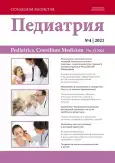Familial hypercholesterolemia: cascade screening along the “child–parent” pathway
- Authors: Sadykova D.I.1, Galimova L.F.1,2, Slastnikova E.S.1,2, Kim Z.F.1,3, Khaliullina C.D.1, Salakhova K.R.1
-
Affiliations:
- Kazan State Medical University
- Children's Republican Clinical Hospital
- City Clinical Hospital №7
- Issue: No 4 (2021)
- Pages: 342-345
- Section: Articles
- URL: https://pediatria.orscience.ru/2658-6630/article/view/100636
- DOI: https://doi.org/10.26442/26586630.2021.4.201303
- ID: 100636
Cite item
Full Text
Abstract
Familial hypercholesterolemia (FH) is the leading cause of premature cardiovascular disease and the most common disorder of lipid metabolism in childhood. Early diagnosis of FH and an effective patient monitoring strategy are extremely promising for reducing the risk of atherosclerosis in the future.
Aim. Conduct and analyze the results of cascade screening along the “child–parent” path for the diagnosis of FH.
Materials and methods. The study was carried out in the period from December 2018 to August 2021 on the basis of Children's Republican Clinical Hospital, City Clinical Hospital No.7 in Kazan, Kazan State Medical University. Inclusion criteria: age 0–17 years inclusive, diagnosed with “Heterozygous form of familial hypercholesterolemia” in accordance with clinical guidelines according to the criteria of the Simon Broome Registry, informed consent for participation in the study of children and/or their parents. Exclusion criteria: underlying diseases/conditions, as well as drugs that may cause a secondary increase in low-density lipoprotein cholesterol.
Results. During this period, 34 children were identified with a diagnosis of heterozygous FH (mean age 8.7±3.6 years). After further examination of relatives, FH was diagnosed in 33 parents, 15 siblings, 56 relatives of the 2nd line of relationship. The average age of the parents was 38±4.3 years. In 20 (60.6%) of them ischemic heart disease was diagnosed, in 18 (54.5%) atherosclerosis of the brachiocephalic arteries. In addition, 10 (30%) patients required coronary angiography, 3 (9%) – coronary artery bypass grafting, 2 (6%) – stenting of coronary vessels.
Conclusion. The diagnostic result of the cascade screening along the “child–parent” path was 3 new cases of FH per one child-proband.
Full Text
About the authors
Dinara I. Sadykova
Kazan State Medical University
Author for correspondence.
Email: sadykovadi@mail.ru
ORCID iD: 0000-0002-6662-3548
D. Sci. (Med.)
Russian Federation, KazanLiliia F. Galimova
Kazan State Medical University; Children's Republican Clinical Hospital
Email: sadykovadi@mail.ru
ORCID iD: 0000-0001-5576-5279
Cand. Sci. (Med.)
Russian Federation, KazanEvgeniia S. Slastnikova
Kazan State Medical University; Children's Republican Clinical Hospital
Email: sadykovadi@mail.ru
ORCID iD: 0000-0002-1732-7443
Assistant
Russian Federation, KazanZulfiya F. Kim
Kazan State Medical University; City Clinical Hospital №7
Email: sadykovadi@mail.ru
ORCID iD: 0000-0003-4240-3329
Assoc. Prof.
Russian Federation, KazanChulpan D. Khaliullina
Kazan State Medical University
Email: sadykovadi@mail.ru
ORCID iD: 0000-0001-6667-7725
Resident
Russian Federation, KazanKarina R. Salakhova
Kazan State Medical University
Email: sadykovadi@mail.ru
ORCID iD: 0000-0001-7327-7025
Resident
Russian Federation, KazanReferences
- Benn M, Watts GF, Tybjærg-Hansen A, et al. Mutations causative of familial hypercholesterolaemia: screening of 98 098 individuals from the Copenhagen General Population Study estimated a prevalence of 1 in 217. Eur Heart J. 2016;37(17):1384-94. doi: 10.1093/eurheartj/ehw028
- Nordestgaard BG, Chapman MJ, Humphries SE, et al. Familial hypercholesterolaemia is underdiagnosed and undertreated in the general population: guidance for clinicians to prevent coronary heart disease: consensus statement of the European Atherosclerosis Society. Eur Heart J. 2013;34(45):3478-90. doi: 10.1093/eurheartj/eht273
- Goldberg A, Hopkins P, Toth P, et al. Familial hypercholesterolemia: screening, diagnosis and management of pediatric and adult patients: clinical guidance from the National Lipid Association Expert Panel on Familial Hypercholesterolemia. J Clin Lipidol. 2011;5:133-40. doi: 10.1016/j.jacl.2011.04.003
- Ежов М.В., Близнюк С.А., Тмоян Н.А., и др. Регистр пациентов с семейной гиперхолестеринемией и пациентов очень высокого сердечно-сосудистого риска с недостаточной эффективностью проводимой гиполипидемической терапии (РЕНЕССАНС). Рос. кардиол. журн. 2019;5:7-13 [Yezhov MV, Bliznyuk SA, Tmoyan NA, et al. Register of patients with familial hypercholesterolemia and patients of very high cardiovascular risk with lipid-lowering therapy underperformance (RENESSANS). Russian Journal of Cardiology. 2019;5:7-13 (in Russian)]. doi: 10.15829/1560-4071-2019-5-7-13
- Ershova AI, Meshkov AN, Bazhan SS, et al. The prevalence of familial hypercholesterolemia in the West Siberian region of the Russian Federation: A substudy of the ESSE-RF. PLoS ONE. 2017;12(7):e0181148. doi: 10.1371/journal.pone.0181148
- Neil HAW, Hammond T, Huxley R, et al. Extent of underdiagnosis of familial hypercholesterolaemia in routine practice: prospective registry study. BMJ. 2000;321(7254). doi: 10.1136/bmj.321.7254.148
- Семейная гиперхолестеринемия. Клинические рекомендации. 2018. Режим доступа: https://noatero.ru/sites/default/files/proekt_klinicheskie_rekomendacii_sghs_mz_rf_18.01.pdf. Ссылка активна на 15.11.2021 [Clinical guidelines. Familial hypercholesterolemia. 2018. Available at: https://noatero.ru/sites/default/files/proekt_klinicheskie_rekomendacii_sghs_mz_rf_18.01.pdf. Accessed: 15.11.2021 (in Russian)].










